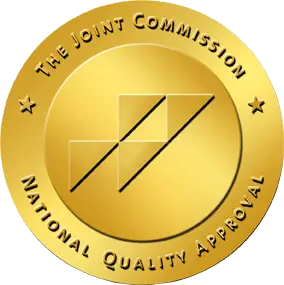Drug use increases the risk of irreversible brain damage, but getting treatment can help you stop using drugs and lower the risk.
Most people know drugs are harmful, but how do they affect your brain and central nervous system? Understanding how drugs affect you can help you anticipate drug use and withdrawal symptoms and their potential complications.
What Do Alcohol and Drugs Do to Your Brain?
When you consume drugs or alcohol, they enter the bloodstream and travel to the brain. The brain is made up of billions of nerve cells (neurons) that communicate using specialized chemicals called neurotransmitters. These neurotransmitters include dopamine, serotonin, GABA, glutamate, endorphins, and more, each of which helps regulate different aspects of mood, pleasure, cognition, movement, and perception.
Neurotransmitter Disruption
Many substances work by hijacking the brain’s communication system:
This Season, Give Yourself the Gift of a Fresh Start.
Whether you are struggling with addiction, mental health or both, our expert team is here to guide you every step of the way. Don’t wait— reach out today to take the first step toward taking control of your life.
- Dopamine Release: Stimulants like cocaine and amphetamines cause a surge of dopamine, leading to intense feelings of pleasure or euphoria. Over time, the brain adapts, producing less natural dopamine or reducing the number of dopamine receptors. This can make it difficult for individuals to feel pleasure without the substance and leads to cravings and dependence.
- Inhibitory Effects: Alcohol, benzodiazepines, and barbiturates enhance the effects of the inhibitory neurotransmitter GABA. This slows down neuronal activity, causing sedation, relaxation, and decreased anxiety. However, if these substances are abused, the brain may produce less GABA on its own or reduce receptors’ sensitivity, creating dependence.
- Serotonin and Other Neurotransmitters: Drugs like MDMA (ecstasy) and LSD primarily affect serotonin, causing heightened or altered sensory perception, mood changes, or hallucinations. Chronic use can result in neurotransmitter depletion, leading to severe depression, anxiety, or other mental health concerns.
Structural and Functional Changes
Beyond altering neurotransmitter activity, chronic substance use can physically reshape and rewire the brain. Areas related to judgment, decision-making, learning, and memory may shrink or become less active:
- Prefrontal Cortex: Responsible for rational thought and impulse control, the prefrontal cortex can become compromised by substance use, leading to poor decision-making and compulsive behaviors.
- Hippocampus: Central to memory formation, the hippocampus may shrink, leading to memory problems or difficulty learning new information.
- Reward Circuitry: Drug use “tricks” the brain into associating substances with survival-level importance. This reinforces cravings and can pave the way to addiction, since the brain learns to prioritize drugs over other activities.
These neurological transformations underpin many of the most significant challenges of addiction. They also help explain why willpower alone is often not enough for recovery — structural and functional changes can be long-lasting, requiring professional treatment, therapy, and sometimes medication to address.
Over time, these disruptions can contribute to a variety of specific disorders and conditions. Below are several such complications tied to substance use.
Cognitive and Behavioral Disorders From Substance Abuse
Substance use can profoundly alter a person’s behavior, cognition, and overall emotional functioning. These issues can range from mild mood swings to more severe psychiatric conditions:
- Depression and Anxiety: Chronic alcohol or drug use disrupts the normal production and regulation of neurotransmitters that govern mood. As a result, individuals may suffer from prolonged periods of depression or heightened anxiety.
- Psychosis and Hallucinations: Stimulants like methamphetamine or cocaine, as well as hallucinogens like LSD, can produce drug-induced psychosis. Symptoms might include paranoia, delusions, and visual or auditory hallucinations.
- Cognitive Impairment: Ongoing substance misuse can result in difficulty with attention, decision-making, planning, and problem-solving. These impairments can make it challenging for someone to carry out daily tasks, maintain employment, or form healthy relationships.
- Personality Changes: Due to changes in the prefrontal cortex, some individuals may exhibit shifts in personality — becoming more impulsive, less empathetic, or more susceptible to risk-taking behavior. Family and friends may notice a stark change in someone’s moral or ethical judgments.
- Dementia and Wernicke-Korsakoff Syndrome: Heavy, prolonged alcohol use can result in thiamine (vitamin B1) deficiency, leading to Wernicke-Korsakoff syndrome, a brain disorder characterized by confusion, memory loss, and lack of muscle coordination. Over time, cognitive deficits can be permanent and lead to alcohol-related dementia.
Collectively, these cognitive and behavioral disturbances can severely affect quality of life. They may emerge or worsen when someone attempts to quit, especially if they try to do so without professional support. Proper treatment and therapy are crucial for helping people relearn healthy coping strategies and regain cognitive function.
Seizures From Withdrawal and Overdose
A seizure is a sudden surge of electrical activity in the brain that can affect behavior, movements, emotions, and levels of consciousness. Various substances can increase the risk of seizures through different mechanisms:
- Alcohol Withdrawal: One of the most common causes of substance-related seizures is alcohol withdrawal. Heavy, long-term alcohol use suppresses the CNS through enhanced GABA activity. When a person suddenly stops drinking, the brain experiences an overactive rebound effect, increasing the risk of seizures. In severe cases, delirium tremens (DTs) can occur, characterized by severe confusion, autonomic instability, and life-threatening seizures.
- Benzodiazepine Withdrawal: Benzodiazepines function similarly to alcohol by enhancing GABA activity. Abrupt cessation can lead to hyperexcitability in the nervous system, resulting in tremors, severe anxiety, and seizures.
- Stimulant-Induced Seizures: Cocaine, methamphetamine, and other stimulants can lower the seizure threshold by increasing dopamine, norepinephrine, and serotonin levels in the brain. This intense overstimulation can lead to convulsions, especially in higher doses or during an overdose.
- Opioid Overdose and Hypoxia: While opioids are CNS depressants that typically do not cause seizures directly, severe overdose can lead to respiratory depression and lack of oxygen (hypoxia). Hypoxia can then trigger seizures, even if indirectly.
Seizures can be unpredictable and life-threatening. They also pose an additional risk of trauma if a person falls or injures themselves during a seizure. People at risk for seizures due to chronic substance use should consider medical detox with proper monitoring and support to reduce the potential for dangerous complications.
Stroke From Prolonged Drug and Alcohol Use
A stroke occurs when the blood supply to part of the brain is interrupted or reduced. This deprives brain tissue of oxygen and nutrients, causing cells to die within minutes. Certain drugs and alcohol can increase stroke risk in several ways:
- High Blood Pressure: Both chronic alcohol misuse and stimulant abuse (cocaine, methamphetamine) can elevate blood pressure and strain blood vessels. Over time, this increases the risk of hemorrhagic (bleeding) stroke due to weakened vessel walls or ischemic stroke from clots that block arteries.
- Cardiac Arrhythmias: Excessive alcohol intake is linked to atrial fibrillation (AFib), an irregular heart rhythm that can cause blood clots to form and travel to the brain, resulting in an ischemic stroke.
- Arterial Damage: Stimulants like cocaine can cause acute vasospasms (sudden constriction of a blood vessel), leading to reduced blood flow or rupture. Chronic stimulation can also cause long-term damage to the arteries, heightening stroke risk.
- Coagulopathy: Certain substances may affect the blood’s ability to clot properly. In people with blood clotting disorders, drug use can exacerbate clotting or bleeding risks.
Stroke is a leading cause of long-term disability. The effects can range from mild weakness or numbness in a limb to paralysis, difficulty speaking (aphasia), or cognitive deficits. Given the correlation between substance use and stroke risk, reducing or stopping use can significantly lower the likelihood of such serious neurological events.
Neuromuscular Disorders From Substance Abuse
Neuromuscular disorders encompass a range of conditions that impair the functioning of nerves and muscles. When alcohol or drugs repeatedly disrupt neural pathways, the body can develop:
- Peripheral Neuropathy: Chronic alcohol misuse, and sometimes other substances, can cause damage to peripheral nerves that control sensations and movement. Symptoms often begin as numbness, tingling, or burning in the hands and feet before potentially leading to muscle weakness and lack of coordination.
- Myopathy: Long-term alcohol use can also cause muscle weakness and wasting, known as alcoholic myopathy. In severe cases, muscle breakdown can release harmful proteins into the bloodstream, leading to kidney damage.
- Neuromuscular Junction Issues: Some substances, including inhalants or designer drugs, may alter communication at the neuromuscular junction, the point where nerve cells signal muscle cells to contract. This disruption can affect muscle tone and coordination.
- Electrolyte Imbalances: Substance use can lead to poor nutrition, dehydration, or imbalances in electrolytes like sodium, potassium, and magnesium. These are critical to nerve conduction and muscle contraction, so imbalances may lead to muscle cramps, spasms, or even paralysis in severe cases.
Neuromuscular disorders can be debilitating and affect everyday activities such as walking, writing, or even swallowing. Early intervention in substance misuse may help slow or halt the progression of neurological damage, but in some cases, the damage might be irreversible.
Movement Disorders Attributed to Substance Abuse
Movement disorders involve abnormal, involuntary, or reduced movements that can significantly reduce quality of life. Drugs, alcohol, and certain medications can contribute to or exacerbate these disorders:
- Parkinsonian Symptoms: Chronic use of some substances can influence the brain’s dopamine pathways, which are crucial for controlled movement. Methamphetamine use, in particular, has been linked to a higher risk of developing Parkinson’s disease or Parkinson-like symptoms, including tremors and rigidity.
- Tardive Dyskinesia (TD): Though primarily associated with long-term use of certain antipsychotic medications, recreational or illicit drugs that heavily disrupt dopamine signaling can theoretically contribute to movement disorders resembling TD (involuntary movements of the face, tongue, or limbs).
- Chorea and Dystonia: Stimulant abuse in high doses can lead to chaotic bursts of movement (chorea) or sustained muscle contractions (dystonia). These can be transient or become chronic, especially if neuronal damage occurs.
- Ataxia: Alcohol misuse is a well-known cause of cerebellar ataxia, characterized by a lack of muscle coordination. Chronic alcohol use damages the cerebellum over time, leading to unsteady gait, poor balance, and coordination issues.
Movement disorders can develop gradually and may not be fully reversible, even with cessation of substance use. However, with proper medical care, symptoms can be managed or stabilized. Rehabilitation programs, including physical therapy and occupational therapy, are often beneficial in improving function and daily living skills.
Traumatic Brain Injury From Substance Abuse
Traumatic brain injury (TBI) occurs when an external force — such as a fall, assault, or car accident — causes damage to the brain. While TBI itself is not directly “caused” by the neurotoxic effects of drugs or alcohol on the brain’s cells, substance use greatly increases one’s risk for an accident or injury:
- Impaired Judgment and Coordination: Alcohol and other CNS depressants slow reaction times, impair coordination, and reduce inhibitions. This increases the likelihood of risky behaviors, such as drunk driving or operating heavy machinery under the influence.
- Heightened Risk-Taking Behavior: Stimulants can heighten confidence and impulsivity, leading individuals to engage in dangerous activities without considering the consequences.
- Falls and Accidents: Individuals under the influence are more prone to slips, falls, and collisions, particularly if they experience blurred vision, dizziness, or delayed reflexes.
- Violence and Trauma: Substance misuse is associated with an elevated risk of involvement in violent altercations or accidents. TBIs may result from physical assaults, including those involving firearms or blunt trauma.
The consequences of TBI range from mild concussion to severe brain damage. Short-term symptoms include headaches, confusion, dizziness, and memory disturbances. Long-term complications can entail cognitive and emotional changes, including persistent confusion, personality changes, depression, and an increased susceptibility to future head injuries.
Early medical intervention after a TBI is critical. If an individual with a TBI also struggles with substance use, a comprehensive treatment plan that addresses both the addiction and the neurological implications is vital for the best possible recovery outcome.
Drugs That Affect the Nervous System
Many drugs can affect the central nervous system. The effects of each drug depend on the different neurotransmitters they activate.
Alcohol, Benzodiazepines and Other Depressants
Alcohol and benzodiazepines work by stimulating GABA receptors. When activated, these receptors suppress other brain signals. Using these substances results in suppressed brain signals, causing relaxation while slowing many of the body’s normal processes.
This effect causes many of the symptoms associated with the use of alcohol and other similar depressants. Symptoms like slurred speech, decreased coordination, forgetfulness or even low heart rate and breathing occur because the hyperactive GABA receptors suppress brain signals in the central nervous system.
Opioid Drugs
Opioid drugs are a type of depressant drug and work by stimulating opioid receptors. Like the GABA receptors that alcohol and benzodiazepines affect, opioid receptors also suppress brain signals. The effects, however, are somewhat different because the receptor type is different. Specifically, opioids cause more physical relaxation than mental relaxation.
The effect of opioids makes them a commonly-used medication for treating severe pain. Opioids can, however, be quite dangerous as they can easily cause relaxation that leads important functions like breathing to slow to dangerous levels or even stop entirely.
Cannabis
The active ingredient of cannabis, or marijuana, activates cannabinoid receptors. These receptors are primarily present in the hippocampus and orbitofrontal cortex. These brain areas help people form new memories, maintain attention and process sensory perceptions. When these receptors are artificially stimulated, it can change how the world is perceived and induce a relaxed state; however, it can also impact memory and the ability to learn.
Cocaine, Methamphetamine and Other Stimulants
Cocaine, methamphetamine and other stimulants activate brain receptors that increase the speed and intensity of brain signals. While multiple central nervous system receptors may be affected, dopamine receptors are the main type impacted.
Using stimulants causes hyperactivity along with a feeling of invigoration and ability. It also strongly impacts the body’s normal processes, increasing heart rate, blood pressure, respiratory rate and other physiological processes. This can cause strain on the body which could be dangerous.
People who use stimulants will typically have a period of hyperactivity where they feel very focused and powerful. They often push themselves beyond what they would normally be capable of without getting tired. A crash follows this period as the effects of the drug wear off, and the period of hyperactivity causes extreme tiredness and fatigue.
Ecstasy
Ecstasy is the commonly-used name for the drug MDMA. MDMA uniquely affects the central nervous system, impacting serotonin, dopamine and norepinephrine receptors. This results in a psychedelic and stimulant effect. Because it causes an altered perception of reality and increases energy, Ecstasy is a popular party drug.
LSD and Other Hallucinogens
LSD and hallucinogens are often referred to as psychedelics. These drugs work on many receptors but are primarily thought to work by affecting serotonin receptors. These drugs create a disconnect from reality, often called a “trip.” This experience can differ significantly each time the drug is used and can be a very pleasurable experience or very unpleasant.
Unlike most other drugs, these drugs don’t just affect how you perceive events; they can completely detach you from your environment and cause you to experience a different reality.
Long-term Damage to the Nervous System
Drugs can cause long-term damage to the central nervous system in many ways. All drugs over-activate neuroreceptors in the brain. When this occurs repeatedly and frequently, the brain adjusts for constant over-activation by decreasing the sensitivity of the receptors, leading to a more normal activation level while using the drug.
However, when the drug is stopped, the receptors are not as active as they should be. This causes withdrawal symptoms until the receptors readjust.
Another type of long-term damage can occur when drug use rewires the brain. Over time, more than just the neuroreceptors are affected. The brain can actually change its structure to make someone want the drug. This effect causes cravings after withdrawal and is what drug rehab is designed to treat.
In addition to brain changes caused by a drug, some drugs can also cause other physical changes that damage the brain. For example, overdosing on opioids can lead to decreased oxygen, affecting brain health and function.
Using stimulants excessively can also cause problems like a stroke, which can lead to permanent brain damage. There are many ways that using different drugs can cause problems that lead to permanent brain damage.
Signs It’s Time To Seek Treatment for CNS Damage
The best way to take care of central nervous system damage is to prevent it from happening in the first place. Often damage to the brain is irreversible, and preventing it is far better than treating it after it develops.
If you have signs that drug use is affecting your central nervous system, you should stop using the drug as soon as possible. Potential signs that drugs are negatively affecting your brain can include:
- Memory problems
- Difficulty learning
- Problems talking
- Decreased coordination
- Hallucinations
- Moods changes, such as depression or anxiety
- Tolerance of the drug
- Cravings for the drug
These signs are especially concerning if they occur while you are not actively using the drug.
Find Help for Substance Misuse & Addiction
Substance addiction isn’t just behavioral; it causes actual changes to your brain. People often need professional treatment to get through withdrawal and stay sober as the brain relearns how to function without drugs. At The Recovery Village at Palmer Lake, we have extensive experience helping people avoid the progression of brain damage by putting a stop to drug use.
If you or your loved one are struggling to quit using a drug, now is the time to act. Continual drug use increases the risk of irreversible brain damage, but it may be mitigated with proactive treatment. The Recovery Village Palmer Lake can help you overcome addiction with evidence-based treatment programs, including inpatient rehab, partial hospitalization and mental health services. Contact us today to see if we can fit your needs and start your journey to achieving lasting recovery.









